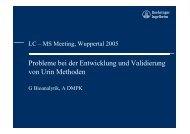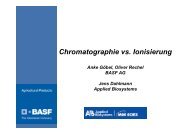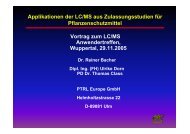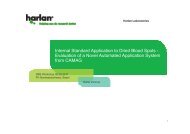6. LC/MS Diskussionstreffen, 29. Nov. 2005, Wuppertal ABSTRACTS
6. LC/MS Diskussionstreffen, 29. Nov. 2005, Wuppertal ABSTRACTS
6. LC/MS Diskussionstreffen, 29. Nov. 2005, Wuppertal ABSTRACTS
Erfolgreiche ePaper selbst erstellen
Machen Sie aus Ihren PDF Publikationen ein blätterbares Flipbook mit unserer einzigartigen Google optimierten e-Paper Software.
Abstracts: <strong>6.</strong> <strong>LC</strong>/<strong>MS</strong> <strong>Diskussionstreffen</strong>, <strong>29.</strong> <strong>Nov</strong>. <strong>2005</strong>, <strong>Wuppertal</strong> 5<br />
Turbulent Flow Chromatography as an Effective Tool for Reducing Matrix<br />
Effects in ESI-<strong>MS</strong>-Based Enzymatic Bioassays<br />
André Liesener and Uwe Karst<br />
University of Twente, Chemical Analysis Group and<br />
MESA + Institute for Nanotechnology, P.O. Box 217,<br />
7500 AE Enschede, The Netherlands<br />
In the analysis of samples originating from enzymatic bioassays by means of electrospray<br />
ionization mass spectrometry (ESI-<strong>MS</strong>), one of the major issues regarding the reliability of<br />
the method is the possible influence of matrix constituents. ESI-<strong>MS</strong> is known to be very<br />
susceptible to both, ionization suppression and ionization enhancement of low molecular<br />
weight analytes in the presence of large biomolecules such as enzymes. In order to minimize<br />
these disturbing effects, it is desirable to remove matrix components prior to the ESI-<strong>MS</strong><br />
analysis. Due to the typically large number of samples, which have to be analyzed during a<br />
complete assay, sample preparation has to be fast and automated. A sample preparation<br />
method fulfilling these criteria is the so-called turbulent flow chromatography (TFC). In this<br />
approach, the samples are directly injected into a high flow rate aqueous mobile phase<br />
stream and transferred onto a microbore column containing a large particle size stationary<br />
phase, where the low molecular weight analytes are retained, while the high molecular<br />
weight compounds and salts are rapidly washed off.<br />
The effectiveness of TFC as means to reduce matrix effects in samples originating from<br />
simultaneous multianalyte mass spectrometric bioassays is explored. In this study, the<br />
effects of enzymes present in the sample on the signal response of five analytes were<br />
simultaneously investigated over a protein content range from 0 �g/mL to 38 �g/mL by<br />
means of direct flow injection mass spectrometry. As model enzymes, trypsin, thrombin and<br />
chymotrypsin were selected. Without TFC, the matrix effects caused both signal suppression<br />
and signal enhancement depending on the nature of the analyte and the amount of matrix in<br />
the sample and were found to be generally intolerably large. The deviation from the mean<br />
signal response as a measure of distortion was found to be between 14% up to 112%. The<br />
addition of an excess of methanol as means of sample clean-up was investigated and found<br />
not to be sufficient. By employing TFC for on-line sample preparation, it was possible to<br />
reduce the matrix effects to a minimum for all model systems investigated. In case of trypsin,<br />
the distortion could be lowered from 41.9% to 2.6%, thus demonstrating clearly the efficiency<br />
of the TFC-based on-line sample clean-up.







